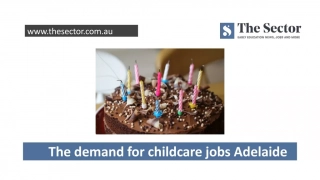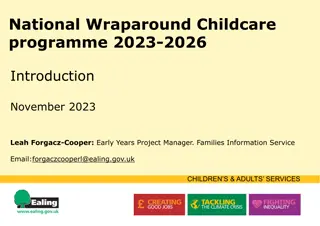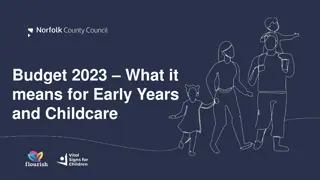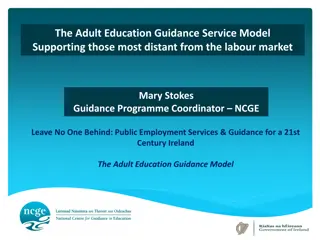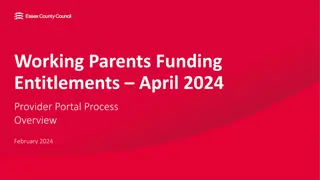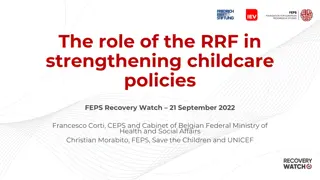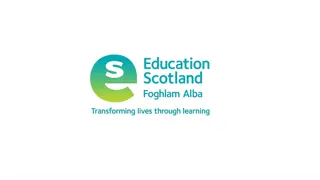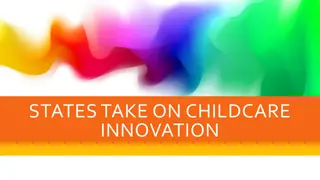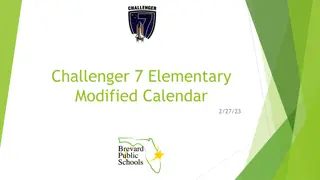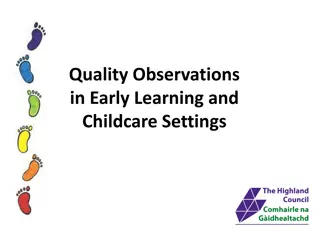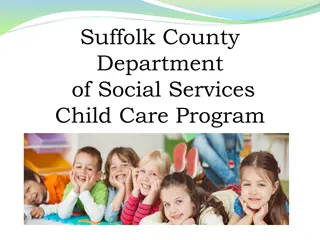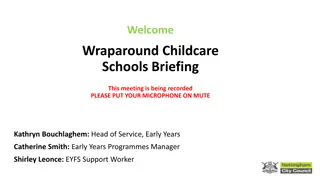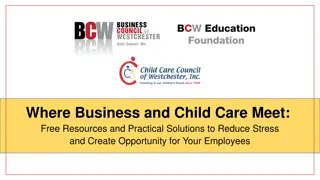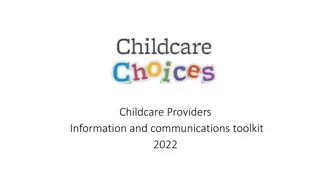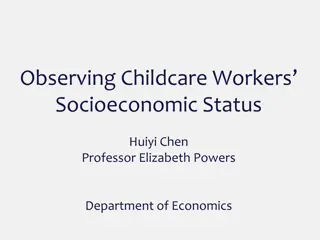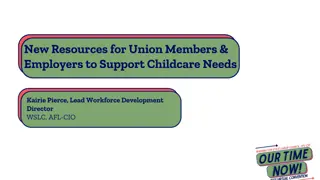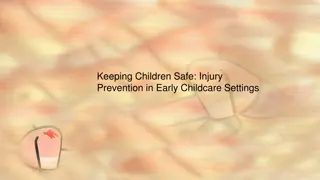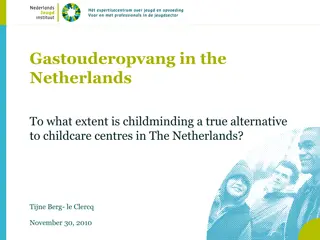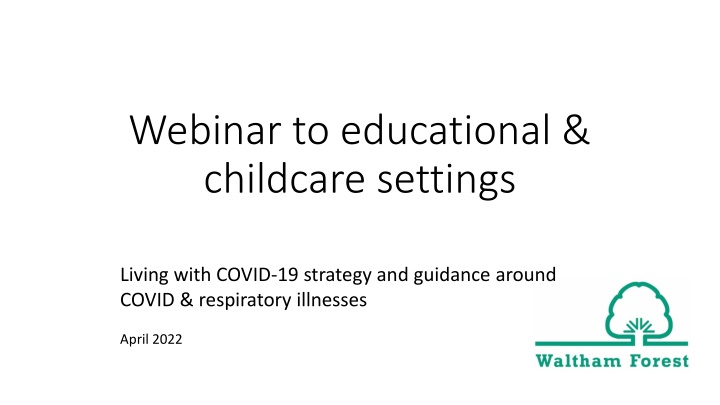
Guidance for Educational & Childcare Settings Living with COVID-19 - April 2022
Stay informed with the latest strategies and guidance for managing COVID-19 and respiratory illnesses in educational and childcare settings. Explore the current situation in Waltham Forest, updates on national and local policies, and the implications for schools and childcare settings. Understand the UK government's living with COVID-19 strategy, including changes to testing recommendations and implications for educational institutions. Stay prepared and safe in the midst of ongoing challenges posed by the pandemic.
Download Presentation

Please find below an Image/Link to download the presentation.
The content on the website is provided AS IS for your information and personal use only. It may not be sold, licensed, or shared on other websites without obtaining consent from the author. If you encounter any issues during the download, it is possible that the publisher has removed the file from their server.
You are allowed to download the files provided on this website for personal or commercial use, subject to the condition that they are used lawfully. All files are the property of their respective owners.
The content on the website is provided AS IS for your information and personal use only. It may not be sold, licensed, or shared on other websites without obtaining consent from the author.
E N D
Presentation Transcript
Webinar to educational & childcare settings Living with COVID-19 strategy and guidance around COVID & respiratory illnesses April 2022
Webinar outline Current situation in Waltham Forest LBWF Changes to national policy what this means for schools and childcare settings - LBWF Changes to local policy what this means for schools and childcare settings LBWF Intro to UKHSA Managing cases of COVID-19 & other respiratory illnesses UKHSA Infection Prevention & Control measures - UKHSA Q&A
Current situation in Waltham Forest Moving just past the peak of the Omicron wave, however levels of COVID-19 remain almost as high as they ve ever been. Less data from testing, recorded data is likely to significantly underestimate the true number of cases. Impact of Omicron has been significantly reduced by vaccination, but without this it is as serious as the original COVID-19 strain. Still putting pressure on the health system and there are still many hospital admissions and deaths recorded in WF every month (third largest cause of death nationally). Illness due to COVID-19 continues to cause large disruption to many sectors, including the education sector. Unclear future, but it is likely to continue to circulate at high levels and new variants present an ongoing threat.
National living with COVID-19 strategy UK Gov living with COVID strategy details removal of restrictions up to and from April 1 2022 (page 22-23) UK Gov - managing COVID-19 in a similar to way to other respiratory illnesses e.g. flu April 1 - living safely with respiratory infections, including COVID-19 guidance April 1 - COVID-19 guidance for schools and childcare settings incorporated into the respiratory illnesses section in Chapter 3 - health protection in schools guidance)
What does this mean for educational and childcare/early years settings? Testing End of free access to testing in most cases Free testing only remains in place for the Clinically Extremely Vulnerable (CEV), health & social care staff Regular asymptomatic (LFD) and symptomatic (PCR) testing no longer recommended (including for SEND schools unless CEV) Tests can be bought from pharmacies but it is not recommended that children & young people test for COVID-19, unless specified by a doctor
What does this mean for educational and childcare/early years settings? Positive test results Confirmed cases of COVID-19 be rare due to removal of free testing and recommendation not to test >18s For children Children and young people aged 18 and under who have a positive test result should stay at home for a minimum of 3 days (from the day after the test was taken) For adults/staff All adults with a positive COVID-19 test result are advised to stay at home and avoid contact with other people for a minimum of 5 days (from the day after the test was taken) This advice is regardless of symptoms. After this period, children/staff should not return to the childcare/education setting until they feel well and do not have a high temperature. Anyone who tests positive advised to avoid those at increased risk of COVID-19 infection for 10 days
What does this mean for educational and childcare/early years settings? Exclusion of pupils/staff with symptoms Covered in next section of the webinar (managing cases and outbreaks) Exclusion of children and staff therefore based on symptoms in many cases Important for settings/parents to be aware of updated COVID-19 symptoms for children and adults a high temperature or shivering (chills) a new, continuous cough a loss or change to your sense of smell or taste shortness of breath feeling tired or exhausted an aching body a headache a sore throat a blocked or runny nose loss of appetite diarrhoea feeling sick or being sick
What does this mean for educational and childcare/early years settings? Contacts of cases Children and young people who usually attend an education or childcare setting and who live with someone who has a positive COVID-19 test result should continue to attend as normal Unless of course they have symptoms that would normally require their exclusion: High temperature and unwell (looking at symptoms) Parents should be vigilant for symptoms
Local changes to COVID guidance April 1 Changes to reporting of cases to LBWF No requirement to routinely notify PH team at Waltham Forest Borough Council of cases and outbreaks of COVID-19 However, if you are concerned by an increase in absences or cases and require support, or if you have any specific queries or concerns, we will continue to provide advice via public.health@walthamforest.gov.uk Updated warn and inform letters to reflect new guidance: high alert for symptoms, stay away from school, vaccination
Local changes to COVID guidance April 1 A note on face coverings No local or national mandate to wear face coverings however; Whilst cases are still high, educational and childcare settings which want to continue to promote face masks will be supported by LBWF (we won t recommend against doing it) Staff and visitors who choose to wear a face covering should be supported to do so Secondary schools: in classrooms and/or communal areas (including corridors and school transport) for pupils and staff Early years and primary schools: in communal areas for staff only
Further resources E bug resources Early years ill or infectious children policy and procedure prompt guidance Health Protection in Education and Childcare settings guidance UK gov Living safely with respiratory infections, including COVID-19 (general) UK gov Schools COVID-19 operational guidance UK gov UK Government Living with COVID-19 strategy UK gov LBWF Linktree page of clinics offering vaccines to those aged 5+, 12-15, 16+ years of age NHS COVID-19 vaccination booking website Recording attendance in relation to COVID-19 during the 2021 to 2022 academic year DfE presentation living with COVID-19, next steps for education and childcare settings


